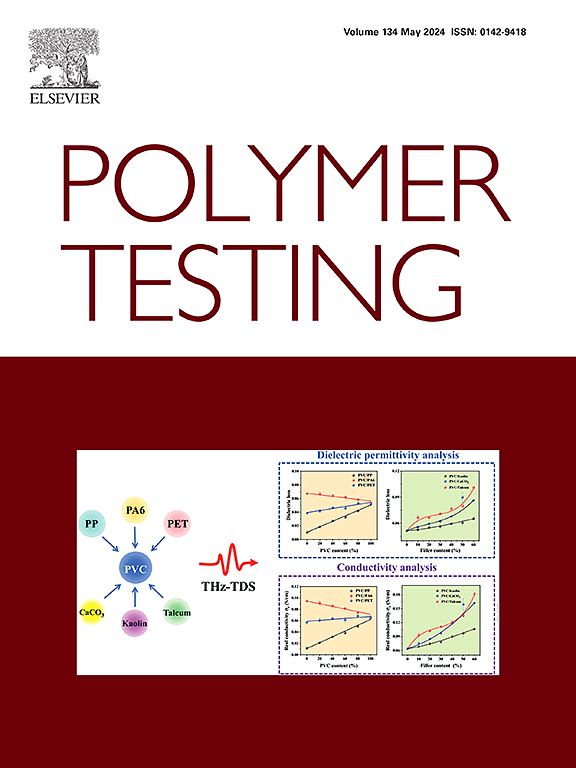用于静电耗散的先进抗静电复合材料:三元乙丙橡胶基导电弹性纳米复合材料的研制
IF 5
2区 材料科学
Q1 MATERIALS SCIENCE, CHARACTERIZATION & TESTING
引用次数: 0
摘要
静电积聚是各行业普遍存在的安全隐患和运行效率低下的问题。有效的静电消散和可靠的防静电解决方案的必要性是一个关键的竞争。本研究首次报道了由新型导电接枝聚合物增强的EPDM基弹性纳米复合材料(ENCs),特别是聚苯胺接枝海泡石(ENC1),聚苯胺接枝氧化石墨烯(ENC2)和聚苯胺接枝海泡石/还原氧化石墨烯(ENC3),具有显著的静电消能能力。这种新方法不仅提高了橡胶的导电性,而且为需要抗静电性能的各种行业的应用开辟了新的途径。用拉曼光谱和傅里叶红外光谱进行了成分分析。扫描电镜形态学研究表明,填料在连续三元乙丙橡胶基体中分布均匀。热重分析表明,由于加入了热稳定的导电填料,所开发的纳米复合材料在高达350°C的温度下具有热稳定性。研究了其作为抗静电材料的电学和力学性能。最小表面电阻率(65 × 103Ω/·)和抗静电半衰期(τ1/2, 0.000005 s)验证了其作为防止敏感电子器件电荷积累的抗静电材料的应用。最大抗拉强度为51 MPa,断裂伸长率为247%。ENC3测得最大交联密度为4.0 × 10−2 mol/cc。通过水接触角和吸水率研究了EPDM板材的疏水性。本研究的见解为下一代新型接枝聚合物填充弹性纳米复合材料的抗静电/静电耗散应用提供了敏锐的洞察力,同时增强了耐用性,环境可持续性和创新的工业用途。本文章由计算机程序翻译,如有差异,请以英文原文为准。

Advanced antistatic composites for electrostatic Dissipation: Development of EPDM based conductive elastomeric nanocomposites
Electrostatic charge buildup is a prevalent challenge instigating safety risks and operational inefficiencies in different industrial sectors. The necessity for efficient electrostatic dissipation with reliable antistatic solution is a critical contest. This study reports for the first time the development of EPDM based elastomeric nanocomposites (ENCs) reinforced by novel electrically conducting grafted polymeres specifically, polyaniline grafted sepiolite (ENC1), polyaniline grafted graphene oxide (ENC2), and polyaniline grafted sepiolite/reduced graphene oxide (ENC3), offering a significant electrostatic dissipation capability. This novel approach not only enhances the conductivity of the rubber but also opens new avenues for applications in various industries requiring antistatic properties. Compositional analyses are carried out by Raman and FTIR spectroscopy. Morphological studies by SEM indicate the homogeneous distribution of fillers in continuous EPDM matrix. Thermogravimetric analysis demonstrated that the developed nanocomposites exhibited thermal stability up to 350 °C, attributed to the incorporation of thermally stable conductive fillers. The electrical and mechanical properties were investigated for their potential use as antistatic materials. The minimum surface resistivity (65 × 103Ω/·) and antistatic half-life (τ1/2, 0.000005 s) validates their application as antistatic material to prevent sensitive electronic devices from charge accumulation. The maximum tensile strength of 51 MPa and elongation at break of 247 % was observed. The maximum cross-link density (ϑ) of 4.0 × 10−2 mol/cc is shown by ENC3. The hydrophobic nature of EPDM sheets was investigated by water contact angle and water absorption %. The insights of this study provide the acumen of next-generation novel grafted polymer filler-based elastomeric nanocomposites for antistatic/electrostatic dissipative applications along with enhanced durability, environmental sustainability, and innovative industrial utility.
求助全文
通过发布文献求助,成功后即可免费获取论文全文。
去求助
来源期刊

Polymer Testing
工程技术-材料科学:表征与测试
CiteScore
10.70
自引率
5.90%
发文量
328
审稿时长
44 days
期刊介绍:
Polymer Testing focuses on the testing, analysis and characterization of polymer materials, including both synthetic and natural or biobased polymers. Novel testing methods and the testing of novel polymeric materials in bulk, solution and dispersion is covered. In addition, we welcome the submission of the testing of polymeric materials for a wide range of applications and industrial products as well as nanoscale characterization.
The scope includes but is not limited to the following main topics:
Novel testing methods and Chemical analysis
• mechanical, thermal, electrical, chemical, imaging, spectroscopy, scattering and rheology
Physical properties and behaviour of novel polymer systems
• nanoscale properties, morphology, transport properties
Degradation and recycling of polymeric materials when combined with novel testing or characterization methods
• degradation, biodegradation, ageing and fire retardancy
Modelling and Simulation work will be only considered when it is linked to new or previously published experimental results.
 求助内容:
求助内容: 应助结果提醒方式:
应助结果提醒方式:


